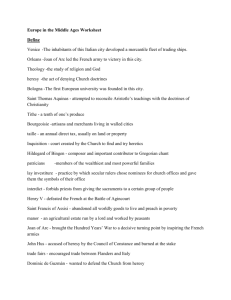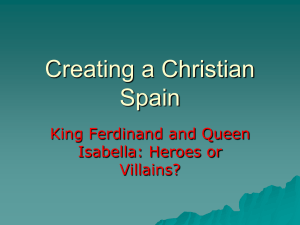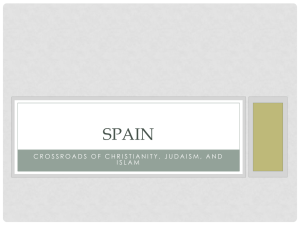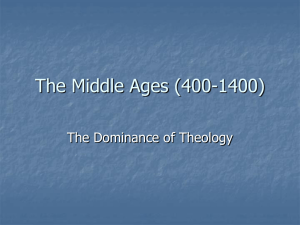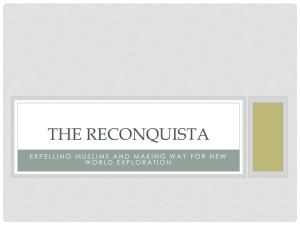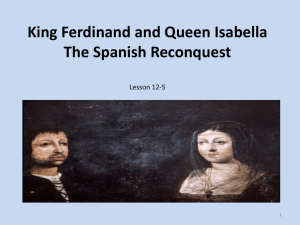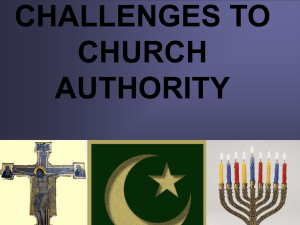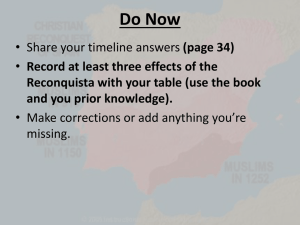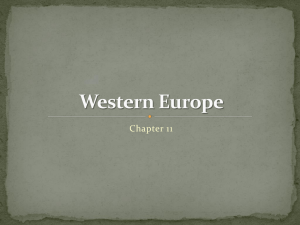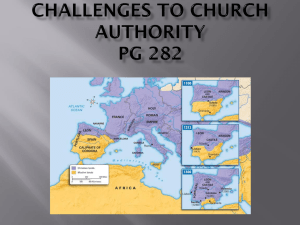Chapter 18 Sections 4-5
advertisement
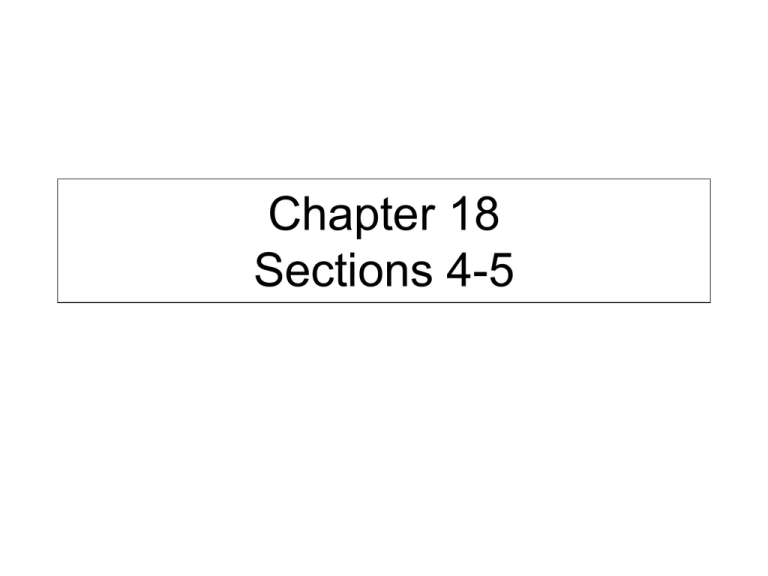
Chapter 18 Sections 4-5 Essential Questions 1. How and why did Europe change politically and socially during the Middle Ages? 2. In the Middle Ages, explain how the church dealt harshly with people who did not respect authority. Section 4: Political and Social Change • • • • Magna Carta Democracy in Europe The Hundred Years War The Black Death Section 5: Challenges to Church Authority • • • • • Heresy Reconquista The Marriage of Ferdinand and Isabella The Spanish Inquisition Jewish Discrimination Political and Social Change The Big Idea Europe’s political and social systems underwent great changes in the late Middle Ages. Main Ideas • Magna Carta caused changes in England’s government and legal system. • The Hundred Years’ War led to political changes in England and France. • The Black Death, which swept through Europe in the Middle Ages, led to social changes. Main Idea 1: Magna Carta caused changes in England’s government and legal systems. In 1215 a group of nobles decided to force King John to respect their rights. They forced him to sign a document called Magna Carta, which in Latin means “Great Charter.” Effects of the Magna Carta • The document granted the right of “habeas corpus,” which meant people could not be put in jail without a reason. Kings could not have people arrested without good cause. • Everyone had to obey the laws, even the king. • The king’s council became Parliament, the lawmaking body that governs England today. By the late Middle Ages, kings could do little without Parliament’s support. • Courts became free of royal control when the king could no longer choose judges. • The Magna Carta began the English people’s movement toward democracy. Main Idea 2: The Hundred Years’ War led to political changes in England and France. Political change also came to France, but it came through war and adversity. The Hundred Years’ War • In 1328 the king of France died without an heir. One potential king was French, and the other was the king of England. • The Frenchman became king, which upset the king of England. The English king invaded France and began the Hundred Years’ War. • After nearly 100 years of fighting, the French troops were rallied by a teenage peasant girl named Joan of Arc. The French drove the English out of France. Results of the War • The English Parliament grew stronger because the king had needed it to help pay for the war. • The king began to lose power as Parliament grew stronger. • In France, the king’s power grew stronger. • Fighting the English formed a bond between the king and the nobles. Main Idea 3: The Black Death, which swept through Europe in the Middle Ages, led to social changes. • While the French and the English fought the Hundred Years’ War, another crisis was sweeping through Europe. The Black Death, a deadly plague, moved quickly through Europe between 1347 and 1351. • The Black Death was caused by several different forms of plague, such as bubonic plague. Effects of the Black Death • The Black Death killed so many people that they were buried without priests or ceremonies. • In some villages nearly everyone died or fled. One million people were killed. • The manor system fell apart because there were not enough people to work the fields. • People abandoned the manors and villages and moved to the cities. Section 5: Challenges to Church Authority • • • • • Heresy Reconquista The Marriage of Ferdinand and Isabella The Spanish Inquisition Jewish Discrimination Challenges to Church Authority The Big Idea In the Middle Ages, the Christian Church dealt harshly with people who did not respect its authority. Main Ideas • The church reacted to challengers by punishing people who opposed its teachings. • Christians fought Moors in Spain and Portugal in an effort to drive all Muslims out of Europe. • Jews faced discrimination across Europe in the Middle Ages. Main Idea 1: The church reacted to challengers by punishing people who opposed its teachings. • By around 1100 some Christians had begun to question the teachings of the church. Religious ideas that oppose accepted church teachings are called heresy. • Heretics are people who have ideas that are believed to be heresy. • Church officials sent priests and friars to find heretics. Some used torture to make people confess. • Most people were found guilty and fined, put into prison, or killed. • Pope Innocent III decided that heresy was widespread and encouraged the king of France to rid the land of heretics. • This began a bloody war that would last 20 years, destroying many towns and lives. Main Idea 2: Christians fought Moors in Spain and Portugal in an effort to drive all Muslims out of Europe. • By the late 900s the Muslim government of Spain had begun to weaken. • The kingdom of Spain fought against the Moors and eventually drove them out of Spain and Europe. • By 1469 Spain was reunited under the rule of King Ferdinand and Queen Isabella. The Spanish Inquisition • Ferdinand and Isabella wanted only Christians in their kingdom. • To make sure that only Christianity was practiced, they created the Spanish Inquisition. • The Spanish Inquisition was an organization of priests who looked for and punished non-Christians. • They were ruthless in their search for heretics, Muslims, and Jews. Most people found guilty were killed by being burned in public. • About 2,000 people died in Spain, and about 1,400 in the Portuguese Inquisition. Main Idea 3: Jews faced discrimination across Europe in the Middle Ages. Heretics and Muslims were not the only groups punished for their beliefs. European Jews also suffered at the hands of Christians who believed Jews were responsible for the death of Jesus. Discrimination against the Jews • Rulers, supported by the church, forced Jews to leave their countries. • In the Holy Roman Empire, frightened people blamed the Jews for the Black Death. Jews had to flee their homes to escape angry mobs.

